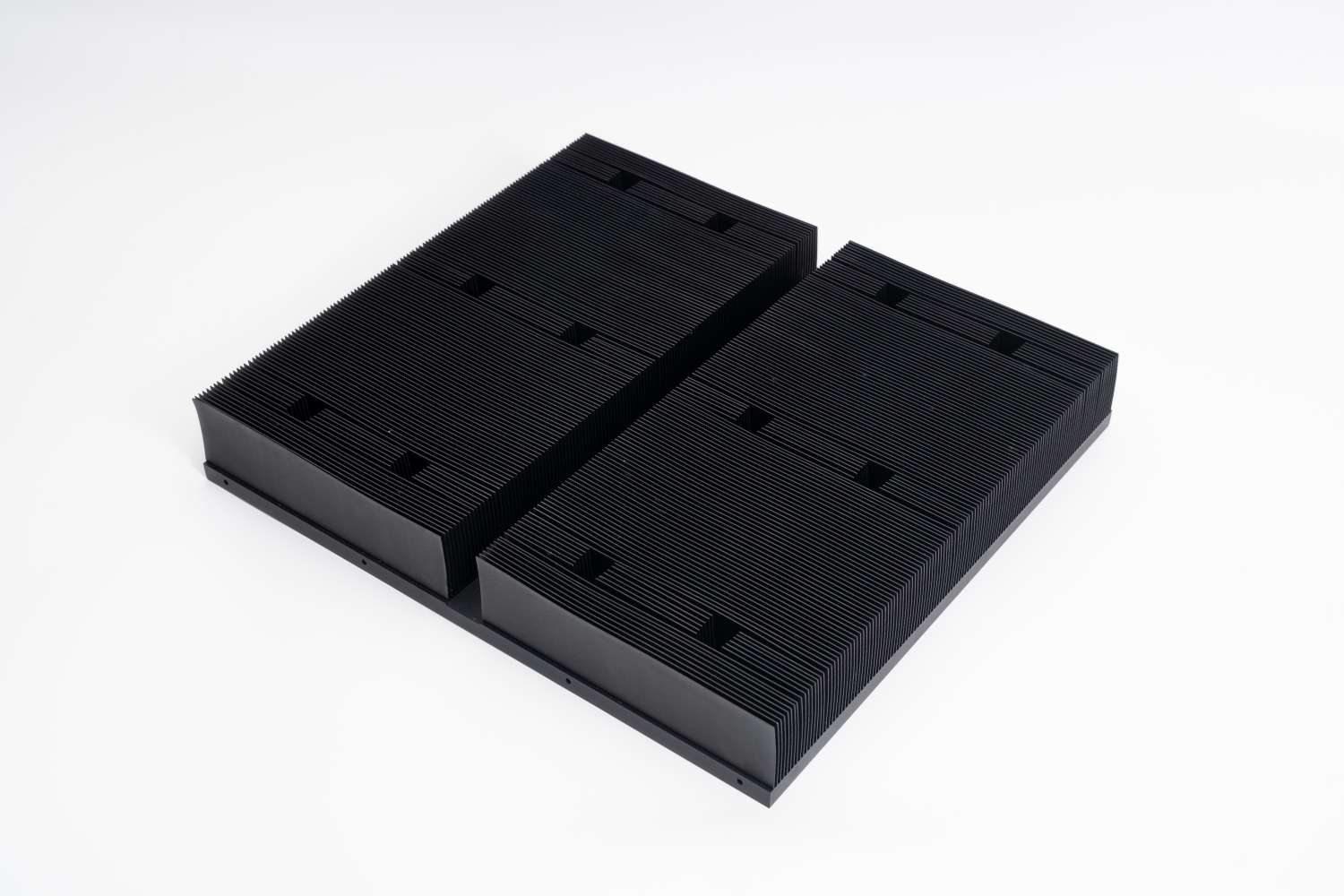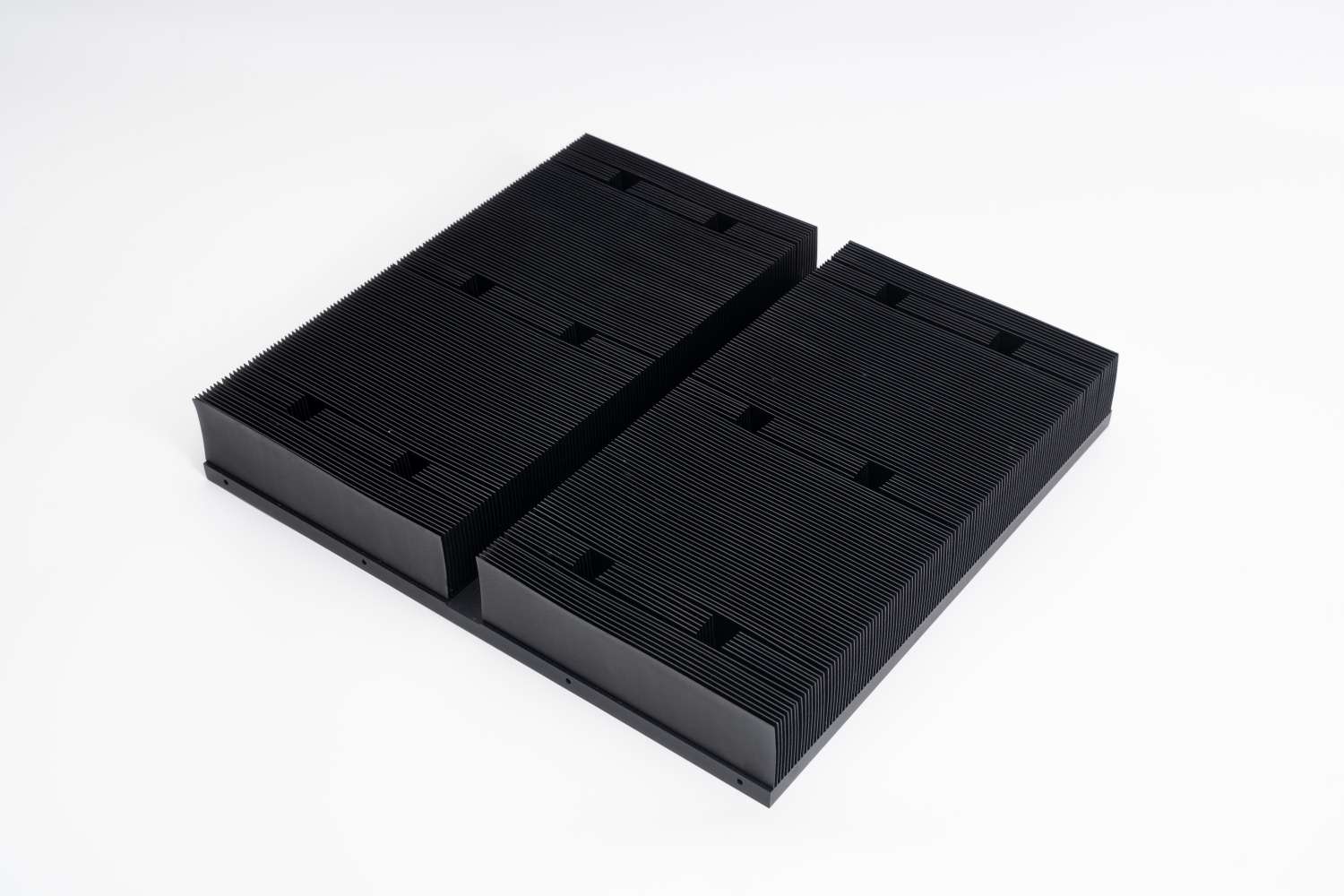


The Aluminum Extruded Radiator is a high-performance passive heat dissipation component, designed for applications in electronic power systems, new energy vehicles, 5G communication, and industrial equipment. Manufactured using advanced extrusion technology, it transforms 6063/6061 aluminum alloy billets into precise heat dissipation structures, including high-density fins, complex flow channels, or irregular shapes, in a single process.
This product combines the efficiency of a 6063/6061 Aluminum Extrusion Heat Sink with lightweight design, high thermal conductivity, and excellent corrosion resistance.

Thermal Performance: The material achieves 201 W/m·K, far surpassing traditional die-cast aluminum, ensuring rapid heat transfer.
Design Innovation: Wave-shaped fins and microchannel layouts improve airflow and increase surface area. This structure can be described as an Extruded Aluminum Cooling Fin, engineered to maximize heat dissipation while minimizing pressure drop.
Thermal Management: Its design allows the radiator to serve as an Aluminum Extruded Thermal Management Component, efficiently controlling temperature in high-power devices.
The density of 2.7 g/cm³ makes it ideal for weight-sensitive applications, including drones and portable power equipment.
Example: A motor radiator made with Extruded Aluminum Radiator technology is significantly lighter than copper alternatives, improving performance without sacrificing durability.
Yield strength ≥240 MPa and elongation ≥8% ensure the component withstands vibration and impact in automotive and industrial environments.
With anodizing treatment, the Custom Extruded Aluminum Radiator achieves high corrosion resistance (salt spray resistance >1000 hours) and electrical insulation, suitable for harsh environments.
The oxide layer also enables safe use in high-voltage electrical cabinets, making it versatile across applications.
High extrusion yield (≥95%) reduces production costs compared to CNC machining or die-casting.
Single extruder capacity reaches 3 tons/day, and molds support high-complexity designs, allowing Custom Extruded Aluminum Radiator solutions to meet varied client requirements.
The combination of extrusion precision and design flexibility enables complex structures such as 6063/6061 Aluminum Extrusion Heat Sink fins, spiral channels, and honeycomb cavities.
Battery Pack Cooling Plate: Double-layer microchannel structure maintains temperature difference ≤2 ℃ during fast charging.
Motor Controller Heat Dissipation: Copper-aluminum composite fins, integrating Extruded Aluminum Radiator technology, reduce junction temperatures efficiently.
Base Station RF Unit: Needle-shaped Extruded Aluminum Cooling Fin ensures thermal resistance ≤0.12 ℃/W.
Server GPU Cooling: VC plate + extruded fin composite modules function as Aluminum Extruded Thermal Management Component, enhancing energy efficiency by 18%.
Photovoltaic Inverters and Energy Storage Systems: Utilize Custom Extruded Aluminum Radiator designs with corrugated fins or foldable water-cooled plates, achieving high heat dissipation density in compact volumes.
The Aluminum Extruded Radiator, whether as a 6063/6061 Aluminum Extrusion Heat Sink, Extruded Aluminum Cooling Fin, or Custom Extruded Aluminum Radiator, provides unmatched thermal efficiency, lightweight construction, corrosion resistance, and cost-effectiveness. It is the ideal solution for high-performance electronic, automotive, communication, and industrial thermal management applications.
Q1: What is an Aluminum Extruded Radiator?
A: An Aluminum Extruded Radiator is a passive heat dissipation component manufactured by forcing 6063/6061 aluminum alloy billets through specialized molds. It forms high-density fins, complex flow channels, or irregular structures in a single extrusion, providing efficient thermal management for electronics, vehicles, and industrial equipment.
Q2: How does an Aluminum Extrusion Heat Sink differ from traditional radiators?
A: Unlike traditional cast or machined radiators, an Aluminum Extrusion Heat Sink eliminates porosity, increases thermal conductivity, and allows for more complex structures like microchannels and wave-shaped fins. This improves heat transfer efficiency while reducing weight.
Q3: What materials are used?
A: Commonly used materials are 6063 and 6061 aluminum alloys, which contain 0.2–0.6% silicon and 0.45–0.9% magnesium. These alloys offer high thermal conductivity, lightweight properties, and excellent corrosion resistance.
Q4: Can the radiators be customized?
A: Yes. Custom Extruded Aluminum Radiator designs are possible, including variable fin thickness (0.5–2 mm), irregular cavities, and cross-sectional complexity ≤8. Molds can be developed in 15–20 days for small or large batch orders.
Q5: What are the advantages of Extruded Aluminum Cooling Fins?
A: They provide:
Increased heat dissipation area with lower air resistance
Higher thermal conductivity than cast aluminum
Lightweight and strong mechanical properties
Long-lasting corrosion resistance after anodizing
Q6: Where can Aluminum Extruded Thermal Management Components be applied?
A: Typical applications include:
New energy vehicles: battery pack liquid cooling plates, motor controllers
5G communication: base station RF units, server GPU cooling
Industrial power: photovoltaic inverters, energy storage systems
Q7: How resistant is the anodized surface?
A: The anodized layer thickness is ≥15 μm (military grade 25 μm), hardness HV 300–400, and can withstand over 1000 hours of salt spray testing. It also provides insulation for high-voltage applications.
Q8: How does it compare to copper in terms of weight and performance?
A: Aluminum extrusions have a density of 2.7 g/cm³, roughly one-third of copper. They achieve comparable or better thermal performance while significantly reducing weight, ideal for drones, EVs, and portable devices.
Q9: Is it suitable for mass production?
A: Yes. The extrusion yield rate ≥95%, single extruder capacity reaches 3 tons/day, and molds last over 50,000 cycles. This makes it highly cost-effective for both small and large-scale production.
Q10: How do I choose the right type for my application?
A: Selection depends on:
Thermal load and required heat dissipation
Size constraints and weight requirements
Type of cooling (air or liquid)
Environmental conditions (corrosive, high voltage, or vibration exposure)

Kingka Tech Industrial Limited
We specialize in precision CNC machining and our products are widely used in telecommunication industry, aerospace, automotive, industrial control, power electronics, medical instruments, security electronics, LED lighting and multimedia consumption.
Address:
Da Long New Village, Xie Gang Town, Dongguan City, Guangdong Province, China 523598
Email:
Tel:
+86 137 1244 4018